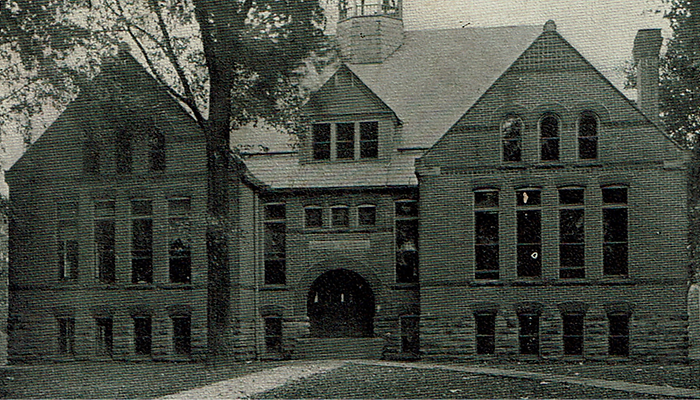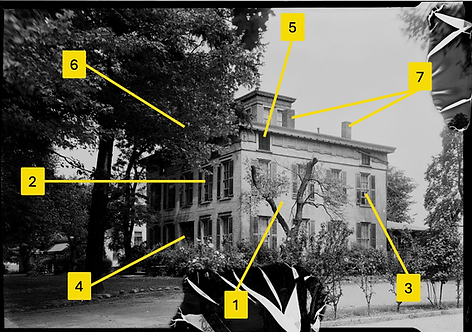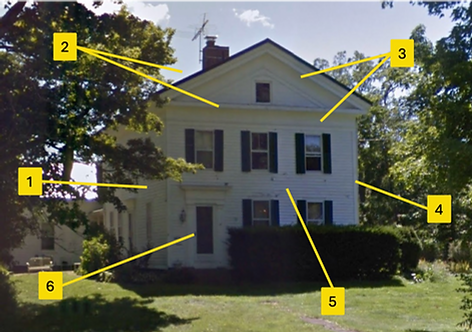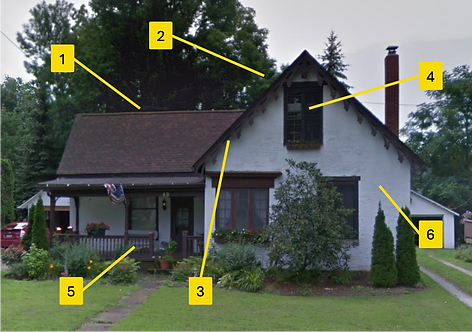Historic Architectural Styles of Seville
Seville boasts a wide range of architectural styles; from its earliest Federal/Greek Revival style homes, to the diverse aesthetic of Victorian architecture, and stunning examples of mid-century and postwar design.
Below is a brief overview of the historic architectural styles found throughout Seville, separated into 4 categories; 19th Century Architecture, Victorian Styles, Early 20th Century, and Modernism.
Planning an exterior restoration, renovation, or addition project? Let us know! We would be happy to help you plan to highlight the architectural features and historic character of your home.

Former Seville Academy
1. 19th Century Architecture
American high-style architecture in the nineteenth century drew much of its inspiration from Europe in the variety of forms and designs of this period. These include the Federal Style, inspired by Roman and Italian Renaissance architecture; the Greek Revival Style, imitating Grecian temples and designs; and the Gothic Revival and Romanesque Revival Styles, both drawing from European Medieval stone churches, castles, and carved decorations.
These styles typically began in New England before spreading west to communities like Seville, where they were adapted to fit local tastes, often known as "Vernacular" variations. Because of this migration and adaptation, these architectural styles often remained popular in Seville long after falling out of fashion in their original locations. Additionally, as new styles became fashionable, local residents often continued using older styles while incorporating elements from the new designs into their homes and buildings. This led to unique combinations that can make it difficult to categorize a home within a single style, but which make Seville's homes unique architectural examples in the region.
FEDERAL STYLE
(ca. 1790 - 1870 locally)
Popular in the early 19th century, many of Seville's early buildings were designed in the Federal Style, although few remain today. This style was influenced by the symmetrical designs of Italian Renaissance villas by Andrea Palladio, reflecting urban prosperity and the growing wealth of the young nation, especially in New England and regional communities like Seville. Federal architecture is known for its grandeur, yet it is lighter and more delicate compared to the heavier Greek Revival Style of the same period. Federal structures often feature classically inspired cornices with decorative modillion or dentil blocks borrowed from Roman or Greek designs, used mainly for decoration rather than their original architectural context. This allowed local architects to creatively adapt these motifs while maintaining the Federal Style's typical features. A notable example is the house at 108 Center Street, built around 1865, which exemplifies the Federal Style with an unusual addition of detailed Greek-inspired molding on the upper third story.
Features:
(1) simple box-shaped buildings, often two rooms deep;
(2) symmetrically arranged windows and doors (usually five bays, less commonly three or seven);
(3) 6-over-6, or 12 over 12 double-hung windows;
(4) recessed paneled entrance with elaborate surround (pediment, pilasters, sidelights, and fanlight);
(5) Roman or Greek influenced dentil molding or other decoration at cornice;
(6) low hipped or side gabled roof;
(7) 2 or 4 chimneys generally near outside wall on either end.

108 Center St. Seville, Ohio
Fashionable taste moved away from the more robust colors toward lighter tones: white, off-white, pale shades of stony gray, and ochre. Bright, clear tones in interiors, often in contrast with pale trim – creams, pumpkins, sage green, muted blues, etc.
-
Body: White, cream, and straw were fashionable, but orange, pea-green, red, and slate met more conservative, traditional tastes.
-
Trim: White, or sometimes the same color as the body.
-
The shutters and doors were dark green or black.
-
House fronts were sometimes painted in fashionable, lighter (and more expensive) colors, while the back and/or the sides were in the more traditional, and cheaper, reds.
-
Rural houses were often unpainted until the middle of the 19th century.
GREEK REVIVAL
(ca. 1820 - 1880 locally)
The American embrace of the Greek Revival Style was driven by a desire to distance themselves from Great Britain (and the British roots of the Federal Style) after the War of 1812, recent archaeological discoveries in Greece, and the Greek War for Independence (1821-30) that sparked American interest and sympathy. Americans saw ancient Greece, the birthplace of democracy, as an ideal architectural inspiration for the United States, to the extent that it was unofficially named the "National style." The Greek Revival Style primarily focused on replicating the elegance and proportions of ancient Greek temples. This led to the creation of rectangular homes that are often 1 ½ to 2 stories tall. Emphasis is often placed on the triangular shape of the pediment at the end of the gable roof, where sculpture would have been displayed in their original Greek counterpart. Historic photos of Seville (available in the SPP Archive) show that many buildings throughout Seville were originally designed in this Greek Revival Style, only to be covered over or remodeled when later designs came into fashion. However, there are many Greek Revival homes throughout Seville that still retain much of the original characteristics, making this an easily recognizable style.
Features:
(1) Simple rectangular buildings with the short side typically facing the street;
(2) gable roof with emphasis on the triangular pediment at the end of the gable, highlighted by trim running entirely across the bottom of the triangular shape or coming in only partially from the bottom corners;
(3) cornice lines accented with a wide band of trim, either plain or slightly decorated, resembling a classical entablature;
(4) pilasters (flat pillar-like trim) especially at the building's corners;
(5) generally symmetrical façade, though the entry is often off-center;
(6) front door surrounded by narrow sidelights and/or a rectangular transom, usually part of an elaborate door surround.

5484 Seville Rd. Seville, Ohio
Colors remained traditional with no technological innovation in colors till 1850s, so the earth-based pigments and natural stone colors of the Federal period are suitable for interiors and exteriors. Interior colors begin to reflect the richness and depth of color of the Victorian period.
-
Body: White or off-white, or stone colors (greys, pale blue greys, grey browns, tans) or straw (ochres and yellows.)
-
Trim: White, off-white, cream
-
Sash: Typically green doors and shutters, and black sash.
-
The most common (almost standard) color scheme: White or off-white body, green doors and shutters, and black sash.
GOTHIC REVIVAL
(ca. 1830 - 1880 locally)
The Gothic Revival style emerged in the mid-19th century as part of the picturesque and romantic movement in architecture, reflecting the public's interest in medieval-inspired buildings. Key examples like the Palace of Westminster (1840-1870) and James Renwick, Jr.'s 1855 Smithsonian Institution "castle" helped popularize the style, which was seen as suitable for rural settings due to its complex and irregular shapes blending with the natural landscape. As a result, Gothic Revival was often chosen for country homes and houses in small towns, like Seville. Carpenter Gothic is a distinctive variation of Gothic Revival, found in many wood-frame homes in Seville. These homes typically feature vertical board-and-batten siding, pointed arches, and intricate wooden trim. The name comes from the extensive use of decorative wood elements on the exterior.
Features:
(1) “L” or “T” shaped structure;
(2) Steeply pitched crossed gabled roof;
(3) Carved or scroll-sawn “bargeboards” at eaves;
(4) prominent window in gable facing the street, often including a pointed arch or other Gothic style detail;
(5) low, single story porch;
(6) brick or wood construction (usually Board and Batton Siding or wood siding designed to mimic stone).

48 East Main St. Seville, Ohio
Paint colors did not change much from the Federal period into the Gothic Revival style: Paints were still mixed by the painter from natural pigments ground into white lead and linseed oil, so many of the earth/stone colors continued to be used. The first “color card” published in the US (1842) included three shades of grey, and three of fawn (called “drab”). Darker, dignified colors were used on larger houses and those in exposed locations: lighter, livelier shades were for smaller, more concealed houses. White, yellow, red, blue, and black were often avoided.
-
Body: Traditional stone- and earth colors, soft and naturalistic to blend in with surroundings.
-
Trim: Historically never white, often a darker shade of the body color, or vice-versa if the body was dark. Sometimes body, trim and sash were painted in three increasingly darker shades of the same color.
-
Sash: Often the same as the trim.
ROMANESQUE REVIVAL
(ca. 1840 - 1910 locally)
The Romanesque Revival in America was partly inspired by the medieval Romanesque style from 11th and 12th century Europe, itself a revival of classical Roman forms. In Seville, this style is less common for homes, where Gothic Revival was preferred. However, Romanesque Revival became popular for public buildings and churches due to its imposing, solid appearance. Notable early examples in Seville, which no longer exist, included the original Village Hall (destroyed by fire) and the former Seville Academy Building (later replaced by Seville Elementary School). The second was built in the "Richardsonian" manner, named after architect Henry Hobson Richardson, who popularized features of the Romanesque Revival Style. Remaining examples in Seville include the Seville Baptist Church, the United Methodist Church, and a commercial building downtown housing The Barber of Seville (at 21 West Main Street and the adjoining building).
Features:
(1) Thick brick or masonry walls;
(2) engaged buttresses, typically at the corners and/or on long walls between windows;
(3) round arches over windows and entryways, with heavy emphasis on the arches and use of circular windows;
(4) projecting, heavy bracketed cornices that emphasize and repeat the arch motif; this style also includes many different textures or different kinds of stone/brick (or suggestion of it) through use of brickwork laid in unusual patterns or the use of different colored materials.

Seville Baptist Church
Suggested colors are listed below, and are typical of the style and period in which the building is constructed, although there is often overlap between styles and periods.
-
Darker and richer colors
-
Greens, dark reds, browns, oranges and olives
-
More complex color combinations
![new logo [transparent].png](https://static.wixstatic.com/media/873ff6_1399327448944fc6be3e206138b383d1~mv2.png/v1/fill/w_162,h_145,al_c,q_85,usm_0.66_1.00_0.01,enc_avif,quality_auto/new%20logo%20%5Btransparent%5D.png)










